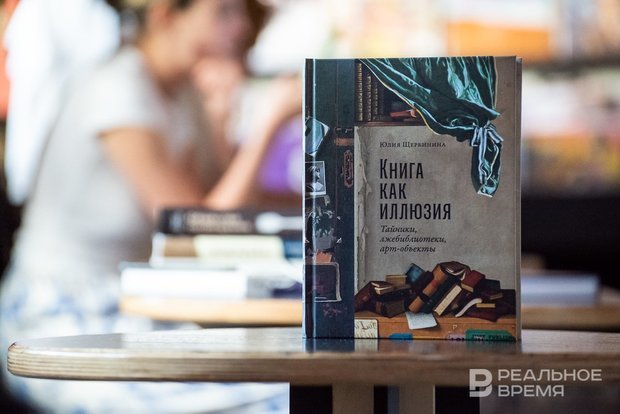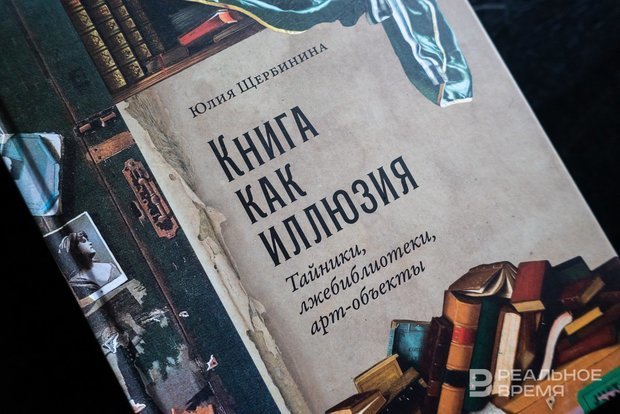Researcher and book critic Yulia Shcherbinina — about world’s most reading country, bookcrossing, and reading practices

In May, Alpina Non-Fiction publishing house published a book by Yulia Shcherbinina, a specialist in book studies and reading practices. The Book As Illusion is an alternative history of book culture, in which a person values not so much the content of a work as its external design. Sectret places, false libraries, dummies, and deceptions — all these are options for non-reader use of the book. Realnoe Vremya met with Yulia Shcherbinina and talked about modern reading practices.
Yulia, how did you come up with the idea to write about the alternative history of the book?
This idea had been maturing for a long time. Initially, I was interested in studying book culture in the visual arts: painting, graphics, sculpture. I started blogging Fata libris/The Fate of Books on social networks. In it, I talk about the representation of the book in the visual arts. In the process of collecting and processing material for the blog, I realised that the book is often not used for its intended purpose. It is not read, but used to decorate interiors or create some kind of visual effects — funny, decorative, illusory. This topic seemed to me worthy of study. But the main thing is that no one has done this in Russia yet.
When I started reading your book, I immediately remembered a country attic. There was a huge thick mattress standing on stacks of old books instead of bed legs.
Oh, I'm sure many will remember similar examples! Often we do not notice such artifacts, they become commonplace for us. A stack of books is also used as a lamp stand or, as in your case, as a base for a bed.

If the book has an alternative history, then this story must have its own crises. How many were there and what are they?
Of course, we do not have the opportunity to look into ancient times, because there are no reliable sources of that period. Therefore, the alternative history of the book begins with the end of the Renaissance. This is the time when the book was still a sacred, especially revered subject. Firstly, because it was associated with Christian culture. And secondly, the book was simply expensive. It was respected and appreciated. In works of fine art, we see how the characters of the painting take a book in gloves, put it on a velvet pillow, wrap it in a cloth.
Then comes the Baroque era — the era of great disappointment, but not in the book, but above all in the possibilities of human cognition. The human mind is nothing before the divine omniscience. And the cult of the book begins not to collapse, but it is no longer so obvious, and the book is no longer omnipotent. In the works of Baroque painting, you can see, for example, how a man smokes a pipe and shakes off the ashes on a book page. Various metamorphoses begin to occur with the book. Just in the Baroque era, so-called “book attractions”, dummies and other artifacts-illusions appear.
During the Enlightenment, “liquor bibles” were popular: a recess was cut out in the book and bottles and glasses were placed there. The name is due to that sacred books were most often used. After all, no one would think of suspecting the Bible of something bad. Now we perceive such artifacts as a sample of bad taste, an example of kitsch.
Every century that replenished such practices was a crisis. And in different countries, the crises were extremely uneven. The processes that we found in the 20th century: mass printing, literature for the people, and a decline of the cult of the book — in many European countries took place in the middle of the 19th century. There was already an abundance of books, they were easily made into dummies and hiding places. The book ceased to be valuable and was cheap. In our country, this happened, rather, in the Soviet era, when banknotes were stored in volumes, some secret materials were hidden. And another practice was also popular: books were bought to match the colour of the wallpaper, scarce works were ordered as interior decoration.
You started talking about the USSR, and I remembered one curious case. On Avito, an ad about the sale of an old library caught my eye. The seller put a low price and stressed that the books are in perfect condition, because they used to belong to a member of a regional committee, which means that no one read them. Was it a trend then?
Here we need to look at the period. At one time in the USSR, there was a stage when there were queues at libraries, and reading rooms were filled. At that time, good literature was in short supply, so books were bought by subscription or received for the waste paper handed over. But on the other hand, there were multi-volumes — for example, the famous collection of works by Dumas, from which only a couple of works were read, and the rest of the “bricks”, as the voluminous volumes were called in bibliophile jargon, turned out to be unclaimed.
As for modernity, there is a different trend now. Many people say that a book is a “dust collector”, abandoning “paper” in favour of electronic texts. On the other hand, there are many people who appreciate printed literature for the beauty of the design, the smell of printing ink, the rustle of paper, and other tactile effects. Each format finds its niche, there is no competition between them. Paper and electronic books occupy their own and, moreover, a worthy place in the culture and in the reader's heart. Everyone chooses the tactics of communication with the book that he likes, this is normal in the modern world.
The Soviet Union was considered the world's most reading country, but is it possible to say this phrase in relation to modern Russia?
No. Let's take Sweden, whose population is smaller than in Moscow. In Sweden, a book can be published in a million copies, while in our country — with a maximum circulation of 300 thousand copies. And this is the limit. So now we are far from being the most reading country.

What do you think about piracy in the context of the value of the book?
I have a big lecture on this issue. In European countries, the issue of piracy has been almost completely resolved, while we are very late. Although there used to be more pirated content. Now people are increasingly realising that this is a surrogate: there are a lot of mistakes in the text, chapters are mixed up, there are no footnotes, etc. Pirated content is only superficially similar to the real one. When people realised this, the trend for pirated copies of books began to wane. I can't say that piracy is a thing of the past, but it's not so big anymore.
In your book, you compare bookcrossing with “throwing books away”. How do you feel about this practice in general?
Previously, people took out and left books on the bench, but now it is called “bookcrossing”. The idea of book exchange is a cultural practice where a book is tracked through certain channels. You can see which way a book has travelled. Now booths for book exchange are being installed in parks and squares, train stations, and shopping centres. In general, this is not bad, you can find quite good literature there. I used to take books at a hotel, and one day I found a great unread book. But it is impossible to track the fate of a book in such cases. The concept of bookcrossing is often speculatively applied to the disposal of unnecessary volumes. Books were taken out of the apartment into the street — it's like they were thrown away.
In the film Moscow Does Not Believe in Tears, they promised that “there will be no theatre or cinema soon”. When will the printed book disappear?
I like the aphorism that people who read books will always control those who watch TV. The book is not a competitor to television. It is clear that the visual format is more popular now. Many will gladly prefer watching movies to reading. After all, reading requires intellectual effort. But I am sure that printed literature will not disappear. Let's take children's books. These are primarily pictures. Similarly, with applied and educational literature. It requires a text format, because it is both more convenient and more hygienic, spares vision. Besides, there are books that we want to keep as a souvenir. In The Book As Illusion, I write that “a room without books is incomplete”. This discussion was relevant back in the 2000s, when the concept of “electronic” appeared, and book formats were adapted to different types of text media. It became obvious that each format found its niche. Readers simply dispersed, everyone chose for himself the way of reading that is convenient and comfortable for him.
One can often hear that paper books are “live” books, electronic books are semi-books, and audiobooks are not books at all. What do you think about it?
It is a complex philosophical question that scientists argue about: what can be called a book? But in any case, the neglect of electronic or audio format, in my opinion, is just snobbery or narrow-mindedness. Every reader, again, is free to choose the most suitable format for him. Unfortunately, I do not perceive the sounding text well. My Book as Illusion has an audio version, moreover, made in a highly professional, very high quality. But when I listened to it, I realised that I was experiencing completely different sensations, as if it was already something “not quite mine”.
What is the difference between the text and the book?
The book is a collective work, and it's not just about the author of the text. An editor, a proofreader, a typesetter, a designer, a typographer work on the creation of the book ... An electronic book is deprived only of a material carrier — a binding, a cover. I am of the opinion that a traditional book is a printed version of the text with a binding. Now the concept of a book is expanding, there are many electronic formats. The printed forms of the book are also actively developing: flipbook, wimmelbuch, partwork, 3D edition… The synthesis of printing and electronics is very interesting — a multimedia interactive book. Artbooks occupy a special place. They usually come in a single copy, can be of different configurations, made of different materials, with author's fonts, or completely unreadable — like art objects. This is a whole art direction that works with the image of the book at its core.
How much can you say about a person by studying his bookshelf?
You can see a lot of books in the apartment, but the question arises: does a person read these books? It happens the other way around: a person has few books on the shelf, but at the same time, he takes a lot of works in the library, reads on electronic media or generally engages in piracy. Everything is ambiguous here. In my opinion, it's bad when there are no books at all.

I noticed that a lot of book clubs have appeared in recent years. Why do you think this trend has become so popular?
A person is a social being, he cannot be alone, and after reading a book, he is looking for like-minded people. He wants to share his opinion, he wants a dialogue, so the clubs allow him to preserve his socio-cultural identity. In my blog, I call such people “book friends”. Besides, there is a certain need to find out how different readers perceive the author's idea, plot moves, characters of the characters. Communication is in the foreground.
By the way, in The Book As Illusion, there is a dedication to “Igor Krasilnikov — my best friend from the book”. I have never seen this person in person. We first met at the presentation of my book in April of this year. We've been communicating online for four years, he helps me with the technical aspects of blogging. Igor is an avid book lover and an enthusiastic collector. Among our contemporaries, I have seen very few such enthusiastic people who so carefully form a home library.
Since the spring of last year, I noticed that many people from my environment run away from reality in reading. How can books be a salvation in such situations?
In my opinion, people are divided into two camps: those who seek salvation in reading, and skeptics who say that this is an idealisation of books. The latter have made their choice and look for salvation in other things — for example, in tourism, sports, volunteering, charity... This is also great! It was books that saved me in the extreme moments of my life — either writing them or reading them. Inside the book world, there are different formats, different genres, different writers. This gives you the opportunity to make a choice to your liking and find a book that will help you survive difficult times.
Author: Yulia Shcherbinina
Book: The Book as Illusion
Publisher: Alpina Non-Fiction
Number of pages: 384
Year: 2023
Ekaterina Petrova is the author of the telegram channel Poppy Seed Muffins (Булочки с маком) and the founder of the first online subscription book club Makulatura.
We thank Smena bookstore for their help.